Elevator
Glossary
|
| If you are in
a rush, just read the first few lines. These are
written with the property manager/ building owner
in mind. Purpose: to assist those coming in
casual contact with elevators, those who read
letters and proposals from elevator companies.
(Some may be embarrassed to ask for an
explanation of basic elevator terms and
technology. This is written to provide a basic
introduction to the industry and technology)
These are not meant to be exacting technical
definitions that no one else can understand. |
CARTOP
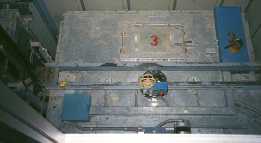 This is what
the top of a typical hydraulic elevator car looks
like. The numeral "3" is stenciled on
the elevator cartop emergency exit. This exit is
normally locked from the top of the car . The two
parallel beams connect the car to the car guides
which ride on the hoistway rails. This is a very
dangerous place to be. This is what
the top of a typical hydraulic elevator car looks
like. The numeral "3" is stenciled on
the elevator cartop emergency exit. This exit is
normally locked from the top of the car . The two
parallel beams connect the car to the car guides
which ride on the hoistway rails. This is a very
dangerous place to be. |
CONTROLLER
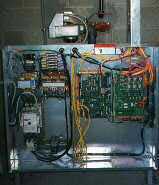 The controller
is the brain of the beast. It controls the
movement and operation of the elevator. The
controller shown here is a Schindler 211
Controller for hydraulic elevators. It is mounted
to the power unit. You can see above the
controller a UV5a valve, which is part of the
power unit. The controller
is the brain of the beast. It controls the
movement and operation of the elevator. The
controller shown here is a Schindler 211
Controller for hydraulic elevators. It is mounted
to the power unit. You can see above the
controller a UV5a valve, which is part of the
power unit. |
COUNTERWEIGHT
It counterbalances the weight of the elevator
car. When the car goes up, it goes down. |
CYLINDER
The stationary lifting component in a hydraulic
elevator. It is often buried in the ground. It is
normally make of a steel tube with a steel cap
welded on the bottom and a head at the top
through which the piston slides. A synthetic
rubber reinforced packing fits into the head of
the cylinder and fits very tightly against the
piston. When the piston is lifting the elevator,
almost all of the load is transferred to the
cylinder and in turn to the elevator pit floor on
which it rests. |
DOOR
OPERATOR
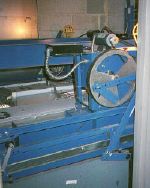 A Rube
Goldberg affair composed of arms, belts, pulleys, chains and a motor that opens and
closes the elevator doors. It is attached to the
top of the elevator car and usually has an arm
that is attached to the car door. When the
elevator car is at a floor, linkages temporarily
connect it to the hall (or hoistway) doors
allowing them to open along with the car door.
Perhaps the most commonly used door operator is
the ubiquitous "G.A.L. operator." If
you want to impress your elevator technician, ask him, "do we have G.A.L. operators on this
car?" A Rube
Goldberg affair composed of arms, belts, pulleys, chains and a motor that opens and
closes the elevator doors. It is attached to the
top of the elevator car and usually has an arm
that is attached to the car door. When the
elevator car is at a floor, linkages temporarily
connect it to the hall (or hoistway) doors
allowing them to open along with the car door.
Perhaps the most commonly used door operator is
the ubiquitous "G.A.L. operator." If
you want to impress your elevator technician, ask him, "do we have G.A.L. operators on this
car?" |
ELEVATOR
A vertically challenging piece of equipment. Not
to be confused with other sorts of contraptions
that have no hoistway enclosure or interlocked
car gates or doors or hoistway gates or doors
with interlocks. If it costs a lot of money, it's an elevator. (all those redundant safety devices
don't come cheaply) If it seems like a real
bargain, it's a Lift in U.S. parlance. This is not
to be confused with a Lift in other countries
which is an elevator here. Got it? |
ELEVATOR
INSPECTOR
You don't always see him, but he usually leaves a
paper trail wherever he goes. It's his job. An
inspector normally inspects your elevators from
two to four times a year.Very few
inspectors actually work for the State of
Pennsylvania, Department of Labor and
Industry-Elevator Division. Most work for an
insurance carrier who actually foots the bill for
their work and in turn bills you for the
inspection.
Like
in any profession, some are better than others
(Well, except for building management. They're
all top notch.)
Have
you ever noticed that they will sometimes find
the most picayune things to write up? Some things
have existed for many years-even since the
elevator was constructed and inspected by that
first inspector eons ago. And though they have
been carefully and methodically doing their job
for ages its only just this week that they find
the screw that needs another quarter turn to make
things just right. Did you ever get suspicious
that they save up little deficiencies as a
squirrel saves nuts, for the time they need
something for their report? Come on ,haven't you
had that thought from time to time? Well, how
dare you. I would never suspect them of anything
like that. And you shouldn't either. They are our
friends and probably also know about this web
page.
Where
do inspectors come from? It is rumored that they
are bred in captivity and fed a strict diet of
Krispy Creme filled donuts, coffee and bowls of
hot chili. But actually they're normally just
recycled elevator mechanics who put years of
knowledge to use following retirement, so you can
rest easy at night and worry about more important
things like R.O.I., and missing Braille plates.
|
ESCUTCHEON
The hole in the hall door, usually near the top
of the door. |
GIB
An often misunderstood, much maligned component.
It is a small piece of metal and plastic that
holds the elevator door in the track. The gib
slides back and forth in the those slots you see
on the floor when you get in and out of the
elevator. There are normally two gibs for each
individual door panel. The plastic part of the
gib actually touches the track in each sill.
There is also a metal part. If there is a fire
and the heat melts the plastic, the metal part is
still there sticking down in the groove and
keeping the door in place and the flames out of
the elevator hoistway.Though small,
a gib is strong. But it takes lots of abuse.
Often, when a door is hit hard, by delivery
people or building tenants, the gibs will bend or
break off. If this happens when the elevator is
moving in the down direction it can cause
extensive and expensive damage to the elevator.
Usually though, the damage is minimal.
I
have heard some managers complain, "Why
don't you make it stronger? I don't think it
should break." If it was made so strong that
it wouldn't break, then something else would bend
or break, and it would be a lot more expensive
than a door gib.
|
GOVERNOR
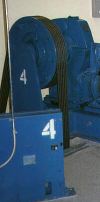 This device
prevents the elevator from overspeeding. When an
elevator overspeeds, the governor
"trips" causing it to grip a cable. The
cable which normally moves up and down with the
elevator, now becomes stationary while the
elevator continues to move. The governor cable
pulls on the safety device and brings the car to
a rapid stop. This device
prevents the elevator from overspeeding. When an
elevator overspeeds, the governor
"trips" causing it to grip a cable. The
cable which normally moves up and down with the
elevator, now becomes stationary while the
elevator continues to move. The governor cable
pulls on the safety device and brings the car to
a rapid stop. |
HOIST
CABLES
 Amazingly
strong steel cables make up of over a hundred
individual wires of high strength flexible steel.
Most traction elevators have at least four hoist
cables. Don't be surprised if not all the grooves
on your elevator machine sheave are filled with a
cable. Sometimes sheaves have additional grooves,
so the sheave can be used for differing
applications. People are often surprised to hear
that the core of each cable is not steel but a
twisted fiber, sort of like a manila rope. Amazingly
strong steel cables make up of over a hundred
individual wires of high strength flexible steel.
Most traction elevators have at least four hoist
cables. Don't be surprised if not all the grooves
on your elevator machine sheave are filled with a
cable. Sometimes sheaves have additional grooves,
so the sheave can be used for differing
applications. People are often surprised to hear
that the core of each cable is not steel but a
twisted fiber, sort of like a manila rope. |
HOISTWAY
The structure that surrounds the elevator.
Sometimes it is partially open at the rear as in
some hotels and office buildings. Hoistways are
meant to be fire resistant enclosures. Normally
the walls, and elevators are all 1 and 1/2 hour
fire rated. Elevator doors normally have a 1 and
1/2 "B" label rating. The elevator door
entrance frames also have this same fire rating.
Sometimes people look for this label. Sometimes
they have come off or been painted over, or are
hard to find. No, no, no, the elevator car doors
(the doors that you can see when you are inside
the elevator) are not required to be fire rated. |
HYDRAULIC
ELEVATOR
An elevator moved by a fluid under pressure,
acting upon a piston. The majority of hydraulic
elevators have a single piston/cylinder design.
The cylinder is usually buried in the ground as
deep as the building's height. The hydraulic
fluid, normally a paraffin based antiwear
hydraulic oil, is designed for operation under
high temperatures and pressures. It is stored in
a tank in the elevator machine room. When you
push a button to go up, a motor begins turning. A
screw type pump forces oil from the tank into the
cylinder. The pressurized oil forces the piston,
which is connected to the elevator car in the up
direction. When you want to come down, the oil in
the cylinder is released through a valve back
into the tank. You will notice when standing in
the machine room, that the elevator sounds
different depending upon whether it is going up
or down. Its always louder in the up direction,
because the motor and pump are turning. To go
down, the valve opens allowing oil back into the
tank. The noise you hear is the oil rushing
through the piping and gushing up into the
reservoir tank. Boring historical tidbit: Some
earlier hydraulic elevators actually used water
as the fluid that lifted the elevator. About 15
years ago I got to see one of these contraptions
in operation in an old Philadelphia building. A
large city water line was hooked up to the
elevator! To make the elevator go up water was
allowed to flow into a monstrous steel and brass
cylinder. When the elevator came down, all this
water simply ran into the sewer system. Can you
imagine the water bill each month?
But that isn't the whole story. To use the water
more efficiently(!) the cylinder actually had
cables wrapped around and around it, with sheaves
attached, here there and everywhere in the
hoistway. When the piston moved one foot, the
elevator moved perhaps 10 feet. |
INSPECTION
REPORT
Your elevator is inspected from two to four times
a year. Though the report is often prepared by a
third party inspection company, it will be issued
to you on very official looking state paper.
Believe it or not, elevator companies don't mind
receiving these reports. It's frequently helpful
to have another party (we all like parties)
having another look see every so often.Important
note: THE ELEVATOR COMPANY DOESN'T KNOW ABOUT THE
REPORT UNTIL YOU GIVE THEM A COPY. It might seem
to make sense that a copy would automatically be
sent to your service company, but that's not how
it works. This is the government. Actually to be
fair to them, it's most important that the owner
gets a copy. It is the owner's responsibility to
then give a copy to the service company. PLEASE
REMEMBER TO INCLUDE ALL PAGES INCLUDING THE LAST
PAGE WITH THE LISTING OF CODES.
|
INTERLOCK
A device designed to keep the elevator hoistway
door (or hall door ) closed when the car is at
another floor. Secondary function: to be a source
of headaches for the elevator technicians. |
MAINTENANCE
CONTRACTS
Elevator maintenance contracts used to be
shorter, simpler and easier to understand. Enter
the lawyers (on boths sides). They are now
sometimes rather ponderous documents made for
lawyers and engineers. At times people seem more
concerned with ancillary issues such as insurance
than in what is really being maintained and the
safety issues surrounding the maintenance.Contract
types:
Full Maintenance-also called names like Complete
and Comprehensive. What is usually included?
Regular preventive maintenance visits and
callbacks, most major parts. What is not
included? any repairs needed as a result of
misuse or vandalism or for reasons outside of the
elevator company's control. This includes acts of
God, power outages, power fluctuations (usually
beyond plus or minus 10%). Potentially big ticket
items like underground piping and cylinders are
also excluded. Additionally, most of these
contracts include straight time callbacks only.
Callbacks for service outside of normal hours
usually result in an invoice being generated for
the overtime portion of the callback plus travel
time costs.
Oil
and Grease-This contract usually includes one
maintenance visit per month. Parts and callbacks
are not included. The contract is less expensive
up front, but back end costs including callbacks
and repairs could end up costing more on an
annual basis than a full maintenance contract.
For lightly used elevators this may be the most
cost effective maintenance program. Many elevator
companies also will not cover very old elevators
on anything but this type of contract.
|
PLATFORM
 This is a
modern elevator platform showing steel stringer
supports, steel sheet fireproofing and attached
hydraulic piston. This design uses a cantilevered
platform, with the piston (the shiny tube) and
hoistway guide rails at the front of the
hoistway. The white tube below the piston is
called the cylinder. The piston lifts the car
when hydraulic fluid is pumped into the cylinder,
which is stationary. Most hydraulic elevators
have the piston at the center of the platform.
This offset piston design is used on low-rise
buildings to keep costs down. This is a
modern elevator platform showing steel stringer
supports, steel sheet fireproofing and attached
hydraulic piston. This design uses a cantilevered
platform, with the piston (the shiny tube) and
hoistway guide rails at the front of the
hoistway. The white tube below the piston is
called the cylinder. The piston lifts the car
when hydraulic fluid is pumped into the cylinder,
which is stationary. Most hydraulic elevators
have the piston at the center of the platform.
This offset piston design is used on low-rise
buildings to keep costs down. |
POWER
UNIT (also called pump unit)
A major component of a hydraulic elevator which
consists of a reservoir tank for the oil, a
motor, pump and valve. Sometimes a controller is
attached to the front or side of the power unit.
This however is at least from an operational
standpoint, considered an entirely separate major
component. |
SAFETY
 We can thank
Elisha Graves Otis for this device. It quickly
brings an elevator to a rapid stop if it
overspeeds while moving in the down direction, by
forcefully gripping the rails. The jaw type
devices are usually attached to the bottom of the
elevator car frame. Buildings having occupied
space under the elevator pit also normally have
safety devices on the counterweight. The original
Otis safety device was designed to work when the
ropes broke, which being then made of fiber were
prone to do. Otis publicly demonstrated his
invention in New York in 1854. Things have been going up since then. His
safe elevators gave people confidence in
elevators and allowed architects to design
increasingly taller buildings. We can thank
Elisha Graves Otis for this device. It quickly
brings an elevator to a rapid stop if it
overspeeds while moving in the down direction, by
forcefully gripping the rails. The jaw type
devices are usually attached to the bottom of the
elevator car frame. Buildings having occupied
space under the elevator pit also normally have
safety devices on the counterweight. The original
Otis safety device was designed to work when the
ropes broke, which being then made of fiber were
prone to do. Otis publicly demonstrated his
invention in New York in 1854. Things have been going up since then. His
safe elevators gave people confidence in
elevators and allowed architects to design
increasingly taller buildings.Pictured at
the top is an old style elevator and safety
device at Sassafras Market, the corner of Race
Street and 3rd Street, Philadelphia, PA.
The
photo at the bottom shows a modern safety device.
The gap being pointed to is where the T-shaped
steel rail passes through the safety device. If
the elevator car were to exceed its predetermined
maximum velocity, these clamps will immediately
grip the rail and bring the elevator car to a
quick stop.
|
SAFETY
TEST
Also called a full load safety test -This test is
performed every five years on traction elevators.
A traction elevator is a elevator in which the
elevator cab or car is moved by cables. If your
elevator has a capacity plate reading 2,500
pounds, then that amount in steel, concrete or
lead weights is placed on the elevator. Both the
governor and safety device are tested during this
test.This test puts
a strain on your elevator equipment. Though
uncommon, damage can occur as part of this test.
Any repairs necessitated as a result of this test
are at an additional cost.
|
TELEPHONE
Many elevators were installed years ago and still
don't have a phone. The latest craze is to use
push to talk, auto dial phones. You push a single
button and the designated phone number is
automatically dialed. They normally require a
dedicated phone line. Some try to hook them up to
an in house line or have it go directly to a
receptionist desk. You may be asking for trouble. |
TRACTION
ELEVATOR
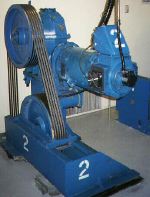 An elevator
that uses cables to move the car. Like the tires
on your car needing traction on the road, the
cables get "traction" by the way they
ride in the grooves of the machine sheave. Also
sometimes called electric elevator, geared
elevator or gearless elevator. An elevator
that uses cables to move the car. Like the tires
on your car needing traction on the road, the
cables get "traction" by the way they
ride in the grooves of the machine sheave. Also
sometimes called electric elevator, geared
elevator or gearless elevator. |
VALVE
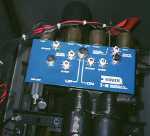 A component of
the elevator power unit (or pump unit) which
controls the speed at which oil flows into and
out of the cylinder, and thereby the speed or
velocity of the elevator. A hard start or stop is
usually related to the valve operation. A component of
the elevator power unit (or pump unit) which
controls the speed at which oil flows into and
out of the cylinder, and thereby the speed or
velocity of the elevator. A hard start or stop is
usually related to the valve operation. |